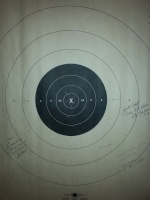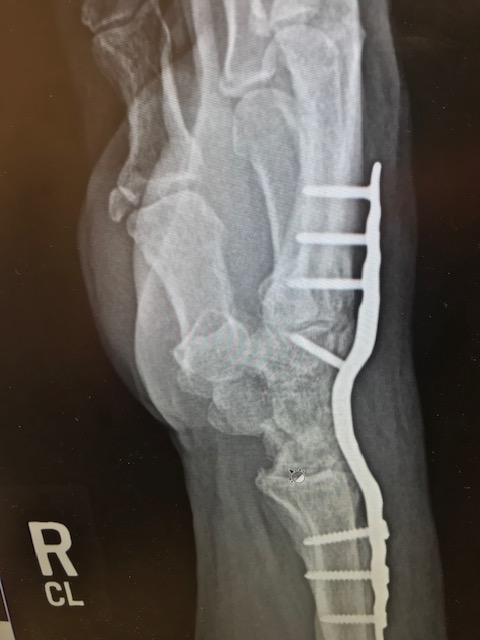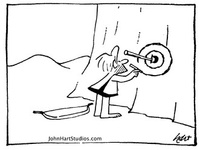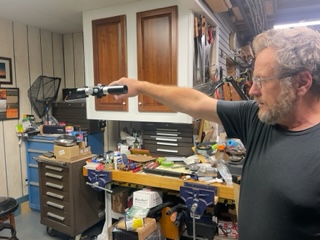The Wrist: Food for Thought?
+18
sbtzc
-TT-
mageepeak
ric1911a1
Gustavo1957
bruce martindale
SteveT
mhayford45
chopper
Jack H
Wobbley
impalanut
DA/SA
chiz1180
Pinetree
SaraiEsq
zanemoseley
Jon Eulette
22 posters
Page 2 of 2
Page 2 of 2 •  1, 2
1, 2
 The Wrist: Food for Thought?
The Wrist: Food for Thought?
First topic message reminder :
I haven’t seen any thing good on fundamentals recently.
I hear people talk about steering the dot into the ten ring. So my question for you is do you know if you are breaking your wrist to do this or are you moving your arm to do this?
If you are breaking your wrist you are setting yourself up for errant shots. Breaking the wrist allows wider forced shots (trigger related) or shots out of the group because you are changing the recoil resistance of your stance. You also lose control of your consistency in a 5 shot string.
When training focus on only allowing movement at the shoulder when aiming and refining (steering) your aim.
When refining aim, remember it’s important to accept your hold. When steering you may find yourself “picking your shots” and not accepting your hold.
Accepting your hold is conducive to good trigger squeeze!
Jon
I haven’t seen any thing good on fundamentals recently.
I hear people talk about steering the dot into the ten ring. So my question for you is do you know if you are breaking your wrist to do this or are you moving your arm to do this?
If you are breaking your wrist you are setting yourself up for errant shots. Breaking the wrist allows wider forced shots (trigger related) or shots out of the group because you are changing the recoil resistance of your stance. You also lose control of your consistency in a 5 shot string.
When training focus on only allowing movement at the shoulder when aiming and refining (steering) your aim.
When refining aim, remember it’s important to accept your hold. When steering you may find yourself “picking your shots” and not accepting your hold.
Accepting your hold is conducive to good trigger squeeze!
Jon

Jon Eulette- Posts : 4399
Join date : 2013-04-15
Location : Southern Kalifornia
Steve Brown, ric1911a1, sig 99 and Multiracer like this post
 Re: The Wrist: Food for Thought?
Re: The Wrist: Food for Thought?
I was on the same relay as Gus........ My Slow Fire didn't look like that.............
Ric
Ric

ric1911a1- Posts : 338
Join date : 2013-05-07
Location : Upstate NY (the good part)
 Re: The Wrist: Food for Thought?
Re: The Wrist: Food for Thought?
Freaking Awesome! A lot of those details are also in my book now. Thanks Gus for your kindness.
Pinetree likes this post
 grip
grip
The comment about keeping your grip while reloading is correct. You should keep the same grip for all 10 shots on a target. Lesson from Jimmy Dorsey.
mageepeak- Posts : 47
Join date : 2012-07-25
 Re: The Wrist: Food for Thought?
Re: The Wrist: Food for Thought?
Gustavo17 wrote:... Bruce helped me go from an average of 240 to 280 for the last 3 years by turning my HS 90 degrees and taking the non wrist action out of play. Takes some time with body mechanics, but you rely on your eye on Red Dot to Center X concentration.
Wait, so you shot gangsta-style, 3 years running?
I've had shoulder issues/surgery too, and discovered that a thumb-up (regular lift) can be tiring. My physical therapist (yes, I told him my goal) explained that a palm-down lift changes the angle of the of the bicep, which feeds back to the shoulder. And it does help (a lot), but I've never had the guts to try it long-term. The red dot needs a totally cockeyed adjustment to make it work, but indoors at a fixed distance that's doable... hmm.

-TT-- Posts : 624
Join date : 2016-10-18
Gustavo1957 likes this post
 Re: The Wrist: Food for Thought?
Re: The Wrist: Food for Thought?
The concept of gripping, in the case of the free pistol, loses its traditional meaning because the anatomical grip guarantees a permanent positioning of the hand. During the shooting process with any pistol the degree of muscular tension in the hand is not important, but rather the continuity of the muscle tone. The firm stabilization of the wrist, without excessive tension in the muscles of the fingers is a solid base for the delicate construction of a shot. When the base is firm, the shooter shoots with more confidence, without fear that one of the muscles will fail at the time of the shot. The autonomous stabilization of the wrist is a very complicated process that demands special training. Unfortunately, many coaches are not aware of this and when young shooters begin to train they do not pay much attention to this issue. After some time, a young and talented shooter reaches a certain level and suddenly his results begin to slip. Usually, it happens in critical moments such as an invitation to participate in the national team. This change in the quality of one’s shooting places an additional load on the novice which may be heavier than he can bear. (There is a wide field of work for the coach and the psychologist to cooperate at this point!). Where he used to shoot naturally, now he has to demonstrate that he’s still capable of shooting at a high level of performance. His fear of failure, his drive and the need to win create a state of stress and the most fragile element can break. Frequently, this element is the stabilization of the wrist....
The basic problem in the stabilization of the wrist is that the muscles of the wrist are not controlled by the central nervous system but by the peripheral nervous system. An inexperienced shooter cannot stabilize his wrist without tensing his fingers. Since the isolated stabilization is not practiced in daily life, the connections of the nerves between the wrist and the central nervous system have almost faded. Only specific long term training can help one recover these connections. The result of this training is the possibility of keeping the pistol within the shooting zone and moving the index finger independently. What else do we need in order to make a sure shot? The shooter has to know how to create muscular tone before the shot that is equal to that after the shot. The following are a few training methods:
Double shots with a semi-automatic pistol. After the first shot, the shooter has to stabilize his new muscular tone, “record” it in his memory and, based on this tone, make his second shot....
Making double shots with air and free pistols. The first shot is made in one’s mind, creating the muscle tone after the “shot” and then shooting for real.
Shooting in series of 20 seconds in standard pistol. The success of this type of shooting depends a great deal on the first shot, since the rest will come out automatically. This automatic process is the result of the creation of muscular tone in the first shot. Twenty seconds for the 5 shots is the ideal time for this type of training, as the intervals between shots are sufficient to avoid haste and they are brief enough to avoid aiming too much, in other words, the conditions are optimal for creating an “automatic pilot” system. Without a doubt, this exercise is the key for pistol shooters....
Conclusion: The most important element of the pistol shooting technique is the firm stabilization of the wrist. Once this technique has been mastered, the shooter is rid of a lot of problems.
-Anatoliy Piddubnyy, "The Vital Problems of Shooting – Part 2", http://www.pilkguns.com/home/anatoli2-shtml/
This action is difficult for one reason: the muscles, responsible for fixing the wrist, are not controlled by the central nervous system (CNS). This is why an untrained person cannot fix the wrist without putting pressure on the fingers. Since the isolated fixation of the wrist is not necessary in everyday life, the nervous connections between the CNS and the wrist are almost non-existent. It is only possible to recover them with very specific, long-term training. This training is possible not only with weapons, but in any situation where one’s hands are free: while watching television, riding on a bus, talking to friends, etc. It is necessary to hold something similar to a grip while trying to fix the wrist without putting too much pressure on the fingers or controlling the degree of fixation with the opposite hand. Imagine we are holding a very heavy egg with a very fragile shell – we cannot grip to hard or relax our fingers. At the same time, we must make the movements of the index finger very slow, but very firm, making sure they are not changing the muscle tone of the wrist.
Anatoliy Piddubnyy, "The Vital Problems of Shooting – Part 1", http://www.pilkguns.com/home/anatoli1-shtml/
The basic problem in the stabilization of the wrist is that the muscles of the wrist are not controlled by the central nervous system but by the peripheral nervous system. An inexperienced shooter cannot stabilize his wrist without tensing his fingers. Since the isolated stabilization is not practiced in daily life, the connections of the nerves between the wrist and the central nervous system have almost faded. Only specific long term training can help one recover these connections. The result of this training is the possibility of keeping the pistol within the shooting zone and moving the index finger independently. What else do we need in order to make a sure shot? The shooter has to know how to create muscular tone before the shot that is equal to that after the shot. The following are a few training methods:
Double shots with a semi-automatic pistol. After the first shot, the shooter has to stabilize his new muscular tone, “record” it in his memory and, based on this tone, make his second shot....
Making double shots with air and free pistols. The first shot is made in one’s mind, creating the muscle tone after the “shot” and then shooting for real.
Shooting in series of 20 seconds in standard pistol. The success of this type of shooting depends a great deal on the first shot, since the rest will come out automatically. This automatic process is the result of the creation of muscular tone in the first shot. Twenty seconds for the 5 shots is the ideal time for this type of training, as the intervals between shots are sufficient to avoid haste and they are brief enough to avoid aiming too much, in other words, the conditions are optimal for creating an “automatic pilot” system. Without a doubt, this exercise is the key for pistol shooters....
Conclusion: The most important element of the pistol shooting technique is the firm stabilization of the wrist. Once this technique has been mastered, the shooter is rid of a lot of problems.
-Anatoliy Piddubnyy, "The Vital Problems of Shooting – Part 2", http://www.pilkguns.com/home/anatoli2-shtml/
This action is difficult for one reason: the muscles, responsible for fixing the wrist, are not controlled by the central nervous system (CNS). This is why an untrained person cannot fix the wrist without putting pressure on the fingers. Since the isolated fixation of the wrist is not necessary in everyday life, the nervous connections between the CNS and the wrist are almost non-existent. It is only possible to recover them with very specific, long-term training. This training is possible not only with weapons, but in any situation where one’s hands are free: while watching television, riding on a bus, talking to friends, etc. It is necessary to hold something similar to a grip while trying to fix the wrist without putting too much pressure on the fingers or controlling the degree of fixation with the opposite hand. Imagine we are holding a very heavy egg with a very fragile shell – we cannot grip to hard or relax our fingers. At the same time, we must make the movements of the index finger very slow, but very firm, making sure they are not changing the muscle tone of the wrist.
Anatoliy Piddubnyy, "The Vital Problems of Shooting – Part 1", http://www.pilkguns.com/home/anatoli1-shtml/
Last edited by sbtzc on 12/7/2022, 2:11 pm; edited 1 time in total

sbtzc- Posts : 189
Join date : 2013-05-21
Location : W CO
 Re: The Wrist: Food for Thought?
Re: The Wrist: Food for Thought?
New and old shooters alike need to learn how to grip keeping trigger finger independent of the gripping fingers.
The entire shot process to some degree is muscle memory through repetition. Hopefully repeating proper fundamentals. Majority of good free/air shooters over the years never mastered the 45 and get their butts kicked because they never developed pulling 3.5# trigger pull weight and being able to shoot 5 consecutive good sustained shots. Free/air typically was lighter grip pressure than what the 45 needed to shoot it well. Nygord always said he squeezed free grip like shaking a little girls hand. That’s pretty soft. Wrist is important but trigger finger is more important. You can fudge stance, breathing, grip to some degree and sight alignment, but you cannot fudge the trigger finger. Wrist breaks more from poor trigger squeeze than recoil: think about that? Trigger rules!
Jon
The entire shot process to some degree is muscle memory through repetition. Hopefully repeating proper fundamentals. Majority of good free/air shooters over the years never mastered the 45 and get their butts kicked because they never developed pulling 3.5# trigger pull weight and being able to shoot 5 consecutive good sustained shots. Free/air typically was lighter grip pressure than what the 45 needed to shoot it well. Nygord always said he squeezed free grip like shaking a little girls hand. That’s pretty soft. Wrist is important but trigger finger is more important. You can fudge stance, breathing, grip to some degree and sight alignment, but you cannot fudge the trigger finger. Wrist breaks more from poor trigger squeeze than recoil: think about that? Trigger rules!
Jon

Jon Eulette- Posts : 4399
Join date : 2013-04-15
Location : Southern Kalifornia
Ed Hall, sbtzc and TonyH like this post
Gustavo1957- Posts : 297
Join date : 2019-09-26
bruce martindale, Outthere and SingleActionAndrew like this post
 Re: The Wrist: Food for Thought?
Re: The Wrist: Food for Thought?
Where’s your brass go? Not kidding!
Jon
Jon

Jon Eulette- Posts : 4399
Join date : 2013-04-15
Location : Southern Kalifornia
Gustavo1957 likes this post
 Re: The Wrist: Food for Thought?
Re: The Wrist: Food for Thought?
Jon,
My brass goes straight up. And then comes down. I usually wear a ball cap. I get hit from other shooters too . My HS 107 functions well.
My brass goes straight up. And then comes down. I usually wear a ball cap. I get hit from other shooters too . My HS 107 functions well.
Gustavo1957- Posts : 297
Join date : 2019-09-26
 Re: The Wrist: Food for Thought?
Re: The Wrist: Food for Thought?
I agree with you but you also have take into account neck angle or head position. Snugging up the waist by shifting shoulders back or forward by about an inch greatly reduces my wobble and improves recovery, at least for International and 22 sports. 45 is a different beast that seems abhor finesse. ThanksJon Eulette wrote:Bruce, I would argue that grip angle does not alter the waist angle. Waist angle is a choice; lean back or stand erect. I will add that as we fatigue, we have a tendency to lean back more to compensate for the lower back regardless of original lean back or standing erect. The wrist has no idea how I am standing, it only cares about sight alignment.bruce martindale wrote:Wrist is interesting, there is a natural wrist angle that is
Jon
 Re: The Wrist: Food for Thought?
Re: The Wrist: Food for Thought?
I'll admit I'm a novice in Bullseye pistole shooting and had to find positions that work for me with my physical disabilities and switch right to left hand depending on the side of surgeries.. As well as a different stance after I shoot my 5 rapid "Luck" target shots my right hand is swelling and that reduces the space the tendons have over the plate in the back of my hand. That starts the increased pain level and loss of grip strength as I continue thru the match. I have to overcome that pain and in my brain and think about finger trigger pressure only. Don't over grip the gun.
As far as repeating exact stance - it's hard. I do go to the line trying to keep my head - eye straight to the Red Dot. But in the end most critical is Eye to Red Dot to Center X.
I think back to rifle shooting when you had to master 4 body positions in the same match. Prone, Sitting, Kneeling and Offhand. Yes you have to be comfortable without losing balance. But you have to concentrate on apertures lining up to center X. Similar to Red Dot. That was back when I didn't need glasses.
Most importantly enjoy the shooting and don't give up.

As far as repeating exact stance - it's hard. I do go to the line trying to keep my head - eye straight to the Red Dot. But in the end most critical is Eye to Red Dot to Center X.
I think back to rifle shooting when you had to master 4 body positions in the same match. Prone, Sitting, Kneeling and Offhand. Yes you have to be comfortable without losing balance. But you have to concentrate on apertures lining up to center X. Similar to Red Dot. That was back when I didn't need glasses.
Most importantly enjoy the shooting and don't give up.


Gustavo1957- Posts : 297
Join date : 2019-09-26
Outthere likes this post
 Re: The Wrist: Food for Thought?
Re: The Wrist: Food for Thought?
With my closed-eye NPA, on my MG2, the sights are aligned well above the target. There's no way I can adjust stance, waist, head position, etc., to fix that. So I stay in my comfortable NPA and then slowly rotate my wrist and begin trigger squeeze as the sights move into alignment. With a 1911, it's the opposite (I rotate up, but less so). I struggle being able to use my forearm muscles to "lock" my wrist in place. But when I'm using those muscles to align the sights, I figure they are firing to some degree, and I noticed that my grip pressure stays pretty constant. It works well as long as you don't stand there too long and start gazing. Is it ill-advised to use "wrist rotation" as a part of the SF shot process?
tovaert- Posts : 455
Join date : 2018-11-28
 Re: The Wrist: Food for Thought?
Re: The Wrist: Food for Thought?
Most shooters lift above the target and then lower into the black. I recommend raising arm/gun to your height you use above the target. Check postition/aim; you should have your correct grip, head position, and now make sure you have correct wrist position. Wrist position is checked by knowing you have correct head position, and red dot centered in the tube/optic. You should only be making minor corrections to this and then lowering arm to shoot. Before you lift arm from bench you should have everything ready; stance, head, grip, arm straightened before lifting with wrist position close to what it should be.tovaert wrote: Is it ill-advised to use "wrist rotation" as a part of the SF shot process?
So with practice this is repeatable every time without having to change anything with exception of very minor adjustments. Train this on blank wall. When using target dry firing or at range you should only be adjusting NPOA with your body/foot position. Don't change what you've been training on the blank wall, because it should remain the same. Only foot position to get NPOA is adjusted.
Jon

Jon Eulette- Posts : 4399
Join date : 2013-04-15
Location : Southern Kalifornia
mhayford45, tovaert and Thin Man like this post
 Re: The Wrist: Food for Thought?
Re: The Wrist: Food for Thought?
Uh, what is NPOA?
It is becoming increasingly clear to me that I need more in person instruction if I want to get better. I can read tons of stuff (and do!) but sometimes someone just needs to -- literally -- hold my hand in the correct position until I get it.
It is becoming increasingly clear to me that I need more in person instruction if I want to get better. I can read tons of stuff (and do!) but sometimes someone just needs to -- literally -- hold my hand in the correct position until I get it.

SaraiEsq- Posts : 172
Join date : 2022-09-25
 Re: The Wrist: Food for Thought?
Re: The Wrist: Food for Thought?
Natural Point of AimSaraiEsq wrote:Uh, what is NPOA?
It is becoming increasingly clear to me that I need more in person instruction if I want to get better. I can read tons of stuff (and do!) but sometimes someone just needs to -- literally -- hold my hand in the correct position until I get it.
Very simply put, walk up to bench pick up gun and lift and settle as you normally would. Where the gun is pointed is your natural point of aim. You want your natural point of aim to be the center of the target. So you adjust position, grip, ect. accordingly. You are basically marrying precision and accuracy together.
If a bullseye clinic is available near (may have to travel a bit) or small arms firing school at Perry probably is a good place to start for in person instruction.

chiz1180- Posts : 1507
Join date : 2019-05-29
Location : Ohio
 Re: The Wrist: Food for Thought?
Re: The Wrist: Food for Thought?
deleted
Last edited by Jack H on 12/13/2022, 4:56 pm; edited 1 time in total

Jack H- Posts : 2698
Join date : 2011-06-10
Age : 75
Location : Oregon
 Re: The Wrist: Food for Thought?
Re: The Wrist: Food for Thought?
Jon, is it wrong to raise the pistol “up” from ready to the target? I’ve experimented both ways recently. The thing that makes a difference to me is that the bullseye is visible when raising up to the target, but it’s not visible when raising above the target and lowering into the bull. When I can see my point coming into the bullseye, my timing is more consistent and the application of smooth increasing pressure seems easier. Then again, it may cause me to anticipate the shot. Not sure. When lowering the pistol into the bull, I sometimes find myself shooting earlier, as soon as I see the sights entering the black. Thoughts on either style?Jon Eulette wrote:Most shooters lift above the target and then lower into the black. I recommend raising arm/gun to your height you use above the target. Check postition/aim; you should have your correct grip, head position, and now make sure you have correct wrist position. Wrist position is checked by knowing you have correct head position, and red dot centered in the tube/optic. You should only be making minor corrections to this and then lowering arm to shoot. Before you lift arm from bench you should have everything ready; stance, head, grip, arm straightened before lifting with wrist position close to what it should be.tovaert wrote: Is it ill-advised to use "wrist rotation" as a part of the SF shot process?
So with practice this is repeatable every time without having to change anything with exception of very minor adjustments. Train this on blank wall. When using target dry firing or at range you should only be adjusting NPOA with your body/foot position. Don't change what you've been training on the blank wall, because it should remain the same. Only foot position to get NPOA is adjusted.
Jon
Thanks for all your help. Oh and btw, to answer your question, I don’t *think* that I am breaking my wrist… but I’ll think about it next time and see.
RodJ- Posts : 921
Join date : 2021-06-26
Location : TX
 Re: The Wrist: Food for Thought?
Re: The Wrist: Food for Thought?
Nothing wrong with lifting to the target. In fact most international pistol events use that method of lift for the match or half the match. Most BE shooters lift above and lower.
Jon
Jon

Jon Eulette- Posts : 4399
Join date : 2013-04-15
Location : Southern Kalifornia
 Re: The Wrist: Food for Thought?
Re: The Wrist: Food for Thought?
Lifting up through the target (black) and then lowering to your aiming area also has the added benefit of checking your target number on the way up.
Lifting way above or starting above makes shooter susceptible to (1) pointing the gun over the berm and (2) coming down on on a target that is not theirs.
CR
Lifting way above or starting above makes shooter susceptible to (1) pointing the gun over the berm and (2) coming down on on a target that is not theirs.
CR
CR10X- Posts : 1777
Join date : 2011-06-17
Location : NC
 Re: The Wrist: Food for Thought?
Re: The Wrist: Food for Thought?
Everyone has their own technique or style of mounting the target.
Jon's way is the old school way and has been done for ever it is also how we were taught when we were in the military for offhand shooting. Some took or take the lift above the target too far and the muzzle is above the berm. With the encroachment of housing developments on our ranges with baffles installed on the firing line to prohibit the high lift adjustments have/had to be made to the style we use.
Whatever works for you works for you and we shouldn't criticize the way others do it since it works for them if anything we should encourage them and explain the different styles and let them choose what works best for them. At Camp Perry there is no berm, so the high lift is seen more than any other style.
I have had to change since the ranges I shoot at were built before the land grab by developers occurred and there are now houses everywhere. Finding a safe place to shoot is fading fast. I still use the lift style but to the top of the target and back down because of range restrictions.
So, let's work together not against each other.
Jon's way is the old school way and has been done for ever it is also how we were taught when we were in the military for offhand shooting. Some took or take the lift above the target too far and the muzzle is above the berm. With the encroachment of housing developments on our ranges with baffles installed on the firing line to prohibit the high lift adjustments have/had to be made to the style we use.
Whatever works for you works for you and we shouldn't criticize the way others do it since it works for them if anything we should encourage them and explain the different styles and let them choose what works best for them. At Camp Perry there is no berm, so the high lift is seen more than any other style.
I have had to change since the ranges I shoot at were built before the land grab by developers occurred and there are now houses everywhere. Finding a safe place to shoot is fading fast. I still use the lift style but to the top of the target and back down because of range restrictions.
So, let's work together not against each other.

Rodger Barthlow- Posts : 392
Join date : 2013-08-10
 Re: The Wrist: Food for Thought?
Re: The Wrist: Food for Thought?
Thank you, Jon Cecil and Rodger. Very helpful, including the “why” behind technique.
Cecil, I shared a dumpster fire story about my last match with Jon. It included “issues” with shooting the wrong target. Your info will be put to excellent use! And Rodger, our club range has experienced the encroachment of new homes and subdivisions. Any safety tips as you have shared are welcome and well appreciated!
Cecil, I shared a dumpster fire story about my last match with Jon. It included “issues” with shooting the wrong target. Your info will be put to excellent use! And Rodger, our club range has experienced the encroachment of new homes and subdivisions. Any safety tips as you have shared are welcome and well appreciated!
RodJ- Posts : 921
Join date : 2021-06-26
Location : TX
 Re: The Wrist: Food for Thought?
Re: The Wrist: Food for Thought?
I prefer to raise up through the target and settle back down.RodJ wrote:Jon, is it wrong to raise the pistol “up” from ready to the target? I’ve experimented both ways recently. The thing that makes a difference to me is that the bullseye is visible when raising up to the target, but it’s not visible when raising above the target and lowering into the bull.
If when I raise the pistol the dot doesn't come straight up through the center of the target I know that either my grip or my stance is a bit off and start over after adjusting.
If the dot isn't aligned with the center of the target when you settle, it seems to me that something isn't correct.
It's like checking my NPA every time I lift.
YMMV!

DA/SA- Posts : 1506
Join date : 2017-10-09
Age : 68
Location : Southeast Florida
Steve Brown likes this post
Page 2 of 2 •  1, 2
1, 2
 Similar topics
Similar topics» What do you eat before a match?
» Wrist Control
» Food for thought on trigger control.
» Limp wrist?
» Wrist Angle
» Wrist Control
» Food for thought on trigger control.
» Limp wrist?
» Wrist Angle
Page 2 of 2
Permissions in this forum:
You cannot reply to topics in this forum

